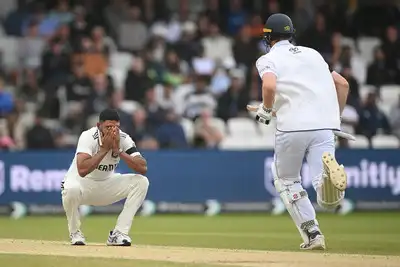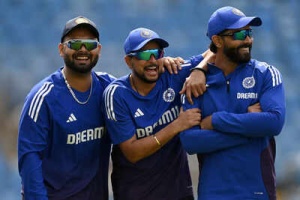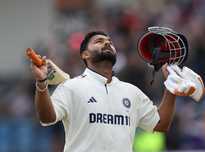India's performance in the first Test against England at Headingley has sparked intense debate about the team's composition and strategy moving forward. Despite posting substantial scores, the visitors succumbed to a heavy defeat, raising concerns about the bowling attack and the batting order's resilience.

Bowling Woes Exposed
In a historic first, India became the first team to lose a Test match after scoring five centuries. The team's aggregate of 835 runs across two innings marks the fourth-highest total in a Test that ended in defeat. The bowlers faced the brunt of the criticism, failing to defend a target of 371 on the final day.
While Jasprit Bumrah impressed with a five-wicket haul in the first innings, his fellow bowlers struggled to maintain consistent pressure. Mohammed Siraj lacked penetration, and Prasidh Krishna, despite taking five wickets, proved expensive. Ravindra Jadeja, the lone spin option, couldn't replicate his usual dominance on spin-friendly Indian pitches.
Despite these concerns, coach Gautam Gambhir hinted at minimal changes to the bowling lineup for the second Test in Birmingham. He praised Siraj's experience and lauded Prasidh's potential.
"Barring Bumrah and Siraj, we don’t have too much experience in the attack. Prasidh bowled very well and got us important wickets. He brings something different to the table with the bounce that he generates and has the ingredients of becoming a very good Test bowler," Gambhir stated.
He emphasized the need to be patient with the younger bowlers, highlighting the importance of building a strong pace attack for the future. "If we start judging our bowlers after every Test, how will we develop a bowling attack?" Gambhir questioned.
Kuldeep Yadav: A Potential Game-Changer?
While Gambhir seems inclined to stick with the core pace trio, the inclusion of Kuldeep Yadav could provide a much-needed boost to the bowling attack. The left-arm wrist-spinner enjoyed a successful run against England in India back in 2023-24, claiming 19 wickets. His ability to trouble batsmen like Harry Brook and Jamie Smith, who struggled against spin in the first Test, could prove invaluable.
Kuldeep's inclusion wouldn't necessarily come at the expense of Ravindra Jadeja, as captain Shubman Gill expressed satisfaction with the all-rounder's performance. Jadeja's economical bowling and ability to contain runs remain valuable assets.
The player most likely to make way for Kuldeep is Shardul Thakur, who had a quiet Test with both bat and ball. However, if the team management prefers a fourth pace option, Karun Nair could be replaced by batting all-rounder Nitish Reddy.
Addressing Late-Order Collapses
India's lower-order batting collapses in both innings also contributed to the defeat. The team lost 13 wickets for just 72 runs, a significant setback. While Gambhir acknowledged the importance of those extra runs, he refrained from blaming the lower-order batsmen.
"It’s not that they are not applying themselves, they are trying. Yes, those extra runs would have been crucial, but I don’t want to blame 9, 10 and 11 for not getting a lot of runs," Gambhir said.
The coach rightly pointed out that scores of 471 and 364 should be sufficient to win a Test match in England. The question now is whether India will opt for a bold strategy of playing five specialist bowlers to capitalize on the strong form of their top-order batsmen.
Newer articles
Older articles
 Gavaskar Calls for Kuldeep Yadav's Inclusion in Second Test Amid Bumrah Fitness Concerns, Cites Edgbaston Spin Advantage
Gavaskar Calls for Kuldeep Yadav's Inclusion in Second Test Amid Bumrah Fitness Concerns, Cites Edgbaston Spin Advantage
 Indian Astronaut Shukla Arrives at ISS, Ushering in New Era for Space Program
OR
India Celebrates as Shukla Reaches ISS, Advancing Ambitious Space Goals
Indian Astronaut Shukla Arrives at ISS, Ushering in New Era for Space Program
OR
India Celebrates as Shukla Reaches ISS, Advancing Ambitious Space Goals
 Rishabh Pant Revolutionizing Cricket, Says Greg Chappell
Rishabh Pant Revolutionizing Cricket, Says Greg Chappell
 Toxic Workplace Warning Signs: Spot the Red Flags Early
Toxic Workplace Warning Signs: Spot the Red Flags Early
 Global Immunization Crisis: Millions of Children at Risk as Vaccine Coverage Lags, Study Reveals
Global Immunization Crisis: Millions of Children at Risk as Vaccine Coverage Lags, Study Reveals
 Moto G54 Price Slashed in India: Check Out the Discounted Rates and Specs
Moto G54 Price Slashed in India: Check Out the Discounted Rates and Specs
 Indian Cricket Star Mukesh Kumar and Wife Divya Singh Announce the Arrival of Baby Boy
Indian Cricket Star Mukesh Kumar and Wife Divya Singh Announce the Arrival of Baby Boy
 IRCTC Launches AI Chatbot 'AskDisha 2.0' to Revolutionize Train Ticket Booking and Customer Service
IRCTC Launches AI Chatbot 'AskDisha 2.0' to Revolutionize Train Ticket Booking and Customer Service
 Cummins Lauds Australia's Dominant Start to WTC Campaign After West Indies Series Win
Cummins Lauds Australia's Dominant Start to WTC Campaign After West Indies Series Win
 Smith Targets Test Return After Innovative Baseball Cage Rehab in New York
Smith Targets Test Return After Innovative Baseball Cage Rehab in New York